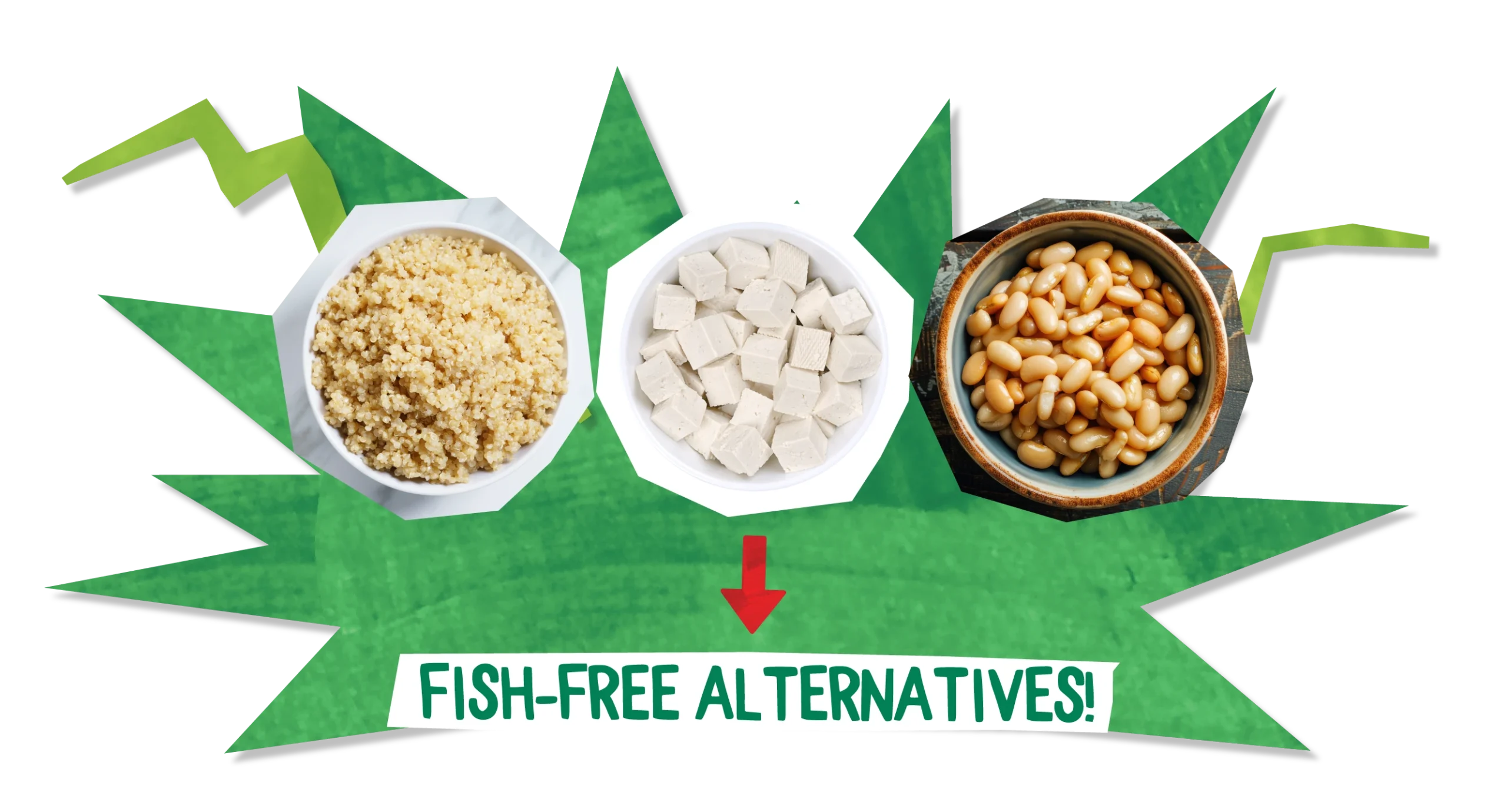Fish and shellfish allergies, also known as seafood intolerance or marine protein allergy, are common and your little one may be affected. To help you understand shellfish hypersensitivity, spot symptoms, and find safe food options, we’ve put together a simple guide filled with information to help you feel more confident in dealing with your little one’s allergy.
Key Takeaways about Fish & Shellfish Allergy
- Fish and shellfish allergies are common food allergies that can cause severe reactions
- Parents should be aware of the symptoms of seafood intolerance in children
- Safe alternatives exist for those with a marine protein allergy
- Careful reading of food labels is essential to avoid allergens
- Support resources are available for families dealing with shellfish hypersensitivity

Understanding fish and shellfish allergy
Fish and shellfish allergies are common but it’s key to know the causes and types of allergens to manage these allergies in your little one.
Defining fish and shellfish allergy
A fish or shellfish allergy occurs when the immune system reacts too strongly to certain proteins in these foods. This can lead to mild symptoms like hives or severe reactions like anaphylaxis. Fish allergies often come from finned fish like cod and tuna whilst shellfish allergies are from crustaceans and molluscs.
Causes of fish and shellfish allergy
The main reason for these allergies is the immune system’s overreaction to proteins in fish and in shellfish. When exposed, the body makes IgE antibodies. These antibodies cause histamine release, leading to allergic symptoms.
Risk factors for developing fish and shellfish allergy
Several factors can increase the risk of your little one developing a fish or shellfish allergy, including…
- Family history of allergies
- Atopic dermatitis (eczema)
- Other food allergies
- Age (children are more susceptible)
- Geographic location (higher prevalence in coastal areas)
Those with a family history of allergies or existing food allergies should be careful with fish and shellfish and people in coastal areas may also face a higher risk due to more seafood consumption.
Identifying symptoms of fish and shellfish allergy
Fish and shellfish allergies can cause a range of symptoms, from mild to severe. Recognising these symptoms early and getting medical help is crucial to avoid your little one from experiencing serious reactions.
Common symptoms of fish and shellfish allergy include…
- Skin reactions: Hives, itching, redness, or swelling
- Digestive issues: Nausea, vomiting, diarrhoea, or abdominal pain
- Respiratory problems: Wheezing, coughing, shortness of breath, or nasal congestion
- Oral allergy syndrome: Itching or tingling in the mouth, throat, or lips
- Anaphylaxis: A severe, potentially life-threatening reaction that can cause difficulty breathing, drop in blood pressure, and loss of consciousness
The symptoms can vary in severity and timing. Your baby might react right away, while other babies may feel symptoms hours later. It’s important to remember that even a small amount of the allergen can cause a reaction in some.

If your child shows signs of fish and prawn allergy, see your baby’s doctor or an allergist as they can do tests to confirm the allergy and help you to manage it. If your baby is displaying severe symptoms, make sure to seek medical help immediately.
Safe alternatives for fish and shellfish allergies

If your child has a fish and/or shellfish allergy, finding safe foods is important. Luckily, there are many plant-based proteins and seafood substitutes that are safe to help avoid allergic reactions.
Plant-based protein sources
Plant-based proteins are great for children with fish and shellfish allergies. They offer important nutrients without the allergy risk. Give these a go…
- Legumes (beans, lentils, peas)
- Tofu and tempeh
- Nuts and seeds (if not allergic)
- Quinoa and other whole grains
Allergy-friendly seafood substitutes
If your little one has a seafood intolerance, there are safe seafood substitutes. They mimic the taste and texture of fish and shellfish in recipes..

Nutritional considerations for fish and shellfish allergy diets
Removing fish and shellfish from your child’s diet is crucial if they have an allergy but it’s still important to ensure they get all the necessary nutrients for healthy growth. Omega-3 fatty acids, iron, and vitamin D are key. A dietitian can help create a meal plan that meets these needs.
Navigating Food Labels for fish and shellfish allergies

Managing a fish or shellfish allergy means reading food labels carefully as this helps avoid marine protein allergens. Knowing about allergen labelling and spotting hidden allergens in food labels is key so you can make safe choices for your little one.
Understanding allergen labelling regulations
In the UK, food makers must label 14 major allergens, such as fish and shellfish. These are highlighted in the ingredients list, often in bold or italics.
Look for “contains” statements too, like “Contains: Fish, Crustaceans”, but always check the full list. The “contains” statement is not always complete.
Identifying hidden sources of fish and shellfish
Fish and shellfish are in many products, not just seafood. Look out for…
- Worcestershire sauce (contains anchovies)
- Caesar salad dressing (contains anchovies)
- Surimi (imitation crab meat, contains fish)
- Certain Asian sauces and condiments (e.g., fish sauce, oyster sauce)
Be careful of cross-contamination, especially in restaurants. Even if a dish doesn’t have fish or shellfish, it might still be contaminated.
Tips for reading food labels
- Always read the ingredients list, even if you’ve purchased the product before, as recipes can change.
- Be aware of alternative names for fish and shellfish, such as “surimi” for imitation crab meat or “crevette” for shrimp.
- If you’re unsure about an ingredient, contact the manufacturer for clarification.
- When dining out, inform your server of your child’s allergy and ask about ingredients and preparation methods.
By understanding allergen labelling, spotting hidden allergens, and following these tips, you can manage your little one’s allergy and make safe, informed food choices.
Rounding off…
Being aware of fish and shellfish allergies is a continuous effort but it’s necessary to keep your child safe if they suffer from a fish or shellfish allergy. Speak with your child’s doctor for the latest info and teach your child, family, and caregivers about the allergy too. This makes a safe space for everyone.
By being proactive, you can help your little one thrive!
FAQ
FREQUENTLY ASKED QUESTIONS
FAQ
Here are some frequently asked questions to help guide you through introducing solids.
Symptoms include skin reactions like hives and itching. Your little one might also have digestive issues like stomach pain and diarrhoea and respiratory problems like wheezing and shortness of breath can also occur. In severe cases, anaphylaxis can be life-threatening. If you think your child has an allergy, see a healthcare professional for help.
Read food labels carefully to find hidden sources. Look for warnings like “contains fish/shellfish” or “may contain traces.” Be careful of products with fish or shellfish derivatives, like fish sauce. Tell restaurants about your child’s allergy and ask about ingredients and how they’re prepared.
All fish and shellfish can trigger an allergy – even tinned varieties.
Hidden fish and shellfish can also be found in Worcestershire sauce (contains anchovies), caesar salad dressing (contains anchovies), surimi (imitation crab meat, contains fish) and certain Asian sauces and condiments (such as fish sauce, oyster sauce).
There are safe alternatives. Plant-based proteins like legumes and tofu are good options. There are also vegan fish fillets and shrimp made from plants. A registered dietitian can help make sure your child’s diet is balanced and nutritious.




